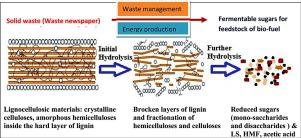Journal of Environmental Chemical Engineering ( IF 7.7 ) Pub Date : 2020-08-11 , DOI: 10.1016/j.jece.2020.104345 Mriganka Sekhar Manna , Saikat Biswas , Tridib Kumar Bhowmick , Kalyan Gayen

|
Environmentally hazardous solid waste is renewed to the feedstock of bio-fuel through the recovery of good quality fermentable sugars by acid hydrolysis of the waste newspapers. Conflicting effects of the variables of acid hydrolysis on the yield of fermentable sugars; and that on the generation of undesired inhibitors to subsequent enzymatic hydrolysis for the production of bio-fuel are compared to select the best condition of hydrolysis. The roles of temperature, acid concentration, the ratio of inorganic to organic acids on the yield of desired total sugars (TS) and lignosulfonate (LS), and that on the reduction of inhibitors such as 5-hydroxymethyl furfural (HMF) and acetic acid with time are studied. The hydrolysis experiments are performed at two different temperatures (80 °C and 121 °C), in the acid concentration range of 0.25-1% (w/v) and with different ratios of two types of acids. The maximum recovery of TS is obtained as 17% (w/w) at an acid concentration of 1% (w/v), the temperature of 121⁰C at a time of 60 min. Both of HMF and acetic acid are produced only at 121⁰C. The best condition of acid hydrolysis is found as the temperature of 121⁰C, a mixture of sulphuric acid to citric acid of the ratio 3:1 at a hydrolysis time of 60 min for higher values of desired TS and LS with a manageable production of inhibitors. The finer tuning of the hydrolysis variables to produce quality fermentable sugars is promising for the economical production of bio-fuel.
中文翻译:

废报纸的酸水解:工艺变量比较,以找到生产优质可发酵糖的最佳条件
通过废报纸的酸水解,回收高质量的可发酵糖,将对环境有害的固体废物更新为生物燃料的原料。酸水解变量对可发酵糖产量的冲突影响;比较产生不需要的抑制剂和随后酶促水解以生产生物燃料的抑制剂,以选择最佳水解条件。温度,酸浓度,无机酸与有机酸的比例对所需总糖(TS)和木质素磺酸盐(LS)的收率以及还原抑制剂(例如5-羟甲基糠醛(HMF)和乙酸)的影响随着时间的推移进行研究。水解实验是在两个不同的温度(80°C和121°C)下进行的,酸浓度范围为0。25-1%(w / v)且两种酸的比例不同。在1%(w / v)的酸浓度和60分钟的121°C温度下,TS的最大回收率为17%(w / w)。HMF和乙酸都仅在121°C下产生。发现酸水解的最佳条件是121°C的温度,在60分钟的水解时间下,硫酸与柠檬酸的比例为3:1的混合物,以获得更高的所需TS和LS值,并且可控制地生产抑制剂。水解变量的微调以产生高质量的可发酵糖对于经济生产生物燃料是有希望的。HMF和乙酸都仅在121°C下产生。发现酸水解的最佳条件是121°C的温度,在60分钟的水解时间下,硫酸与柠檬酸的比例为3:1的混合物,以获得更高的所需TS和LS值,并且可控制地生产抑制剂。水解变量的微调以产生高质量的可发酵糖对于经济生产生物燃料是有希望的。HMF和乙酸都仅在121°C下产生。发现酸水解的最佳条件是121°C的温度,在60分钟的水解时间下,硫酸与柠檬酸的比例为3:1的混合物,以获得更高的所需TS和LS值,并且可控制地生产抑制剂。水解变量的微调以产生高质量的可发酵糖对于经济生产生物燃料是有希望的。


























 京公网安备 11010802027423号
京公网安备 11010802027423号